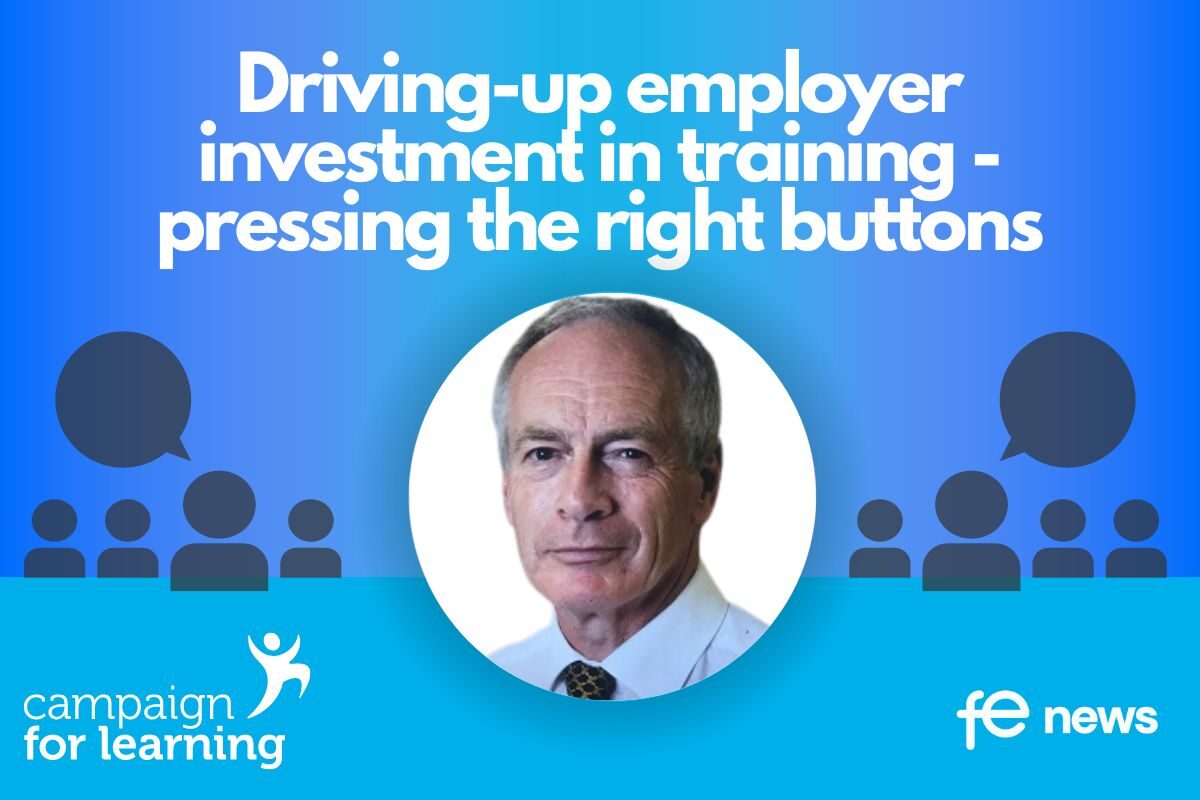Increasing employer demand for higher technical education and training in England

Henry Ford is perhaps the most eloquent champion of the power of staff development. He is famously quoted as saying, “the only thing worse than training your employees and having them leave, is not training them and having them stay”.
Ford also assumed that once trained, employees are ungrateful. But here Ford was wrong. Evidence suggests staff training increases loyalty – a real win-win.
Lost messages
Sadly, these messages are being lost on many of our employers. We know from the Learning and Work Institute that investment in training by employers in the UK has fallen by 28% per employee since 2025.
Perhaps unsurprisingly, the National Institute for Economic and Social Research has found that UK adjusted labour productivity between 2008– 2019 ran at an anaemic annual rate of 0.27%, compared to 0.7% in France and Germany, and 1% in the US.
Employer decision making
So, if staff development investment is such a good thing, why are employers so reluctant to embrace it, and how can we encourage increased employer demand for training and education, especially demand for higher technical education where the skills gaps are most acute?
Perhaps the best starting point is to consider how decisions are made. When a business considers investing in its staff, it will go through the same decision process as it would for capital investment, R&D and innovation. What is it looking to achieve? How much should it invest? Is it affordable? How much return will it get?
Drivers of employer investment
When looking at what it wants to achieve, the nature of an organisation can be important. Private organisations generally see return in terms of profit. Public service organisations see returns as more effective, efficient or economic services.
Data from the Office for National Statistics shows average profit margins of between 9% for manufacturing and 14% for service industries. Investment in training therefore needs a clear link to improved profit, with knowledge gained being applied immediately to profitable effect.
Size of employers
Many large professional firms have a long tradition of high-level management development programmes, often in-house. If they are satisfied with that investment, new initiatives might be exploited to reduce the costs of existing activity.
Data for UK companies shows most private employers are tiny – not much bigger than a traditional family – and as such, are unlikely to have regular major development programmes.
Employer investment in training and employment duration
Return on investment partly depends on the duration of employment. Data for UK companies shows the average worker spends less than five years with an employer, so returns have to be swift and sure.
Existing employer investment linked to immediate need
The pressure to link investment in training by employers to either profitability or improved service delivery, and the average duration of employment of less than five years, means employer investment in training is unsurprisingly focused on immediate impact and business improvement.
Employer wins are actually at Level 2 and below
For colleges such as Bedford, employers see quick wins from lower-level training like language proficiency (ESOL and Basic English), mathematical competence (maths to Level 2), and computer literacy (use of common applications like Microsoft). The benefits to businesses from technical education at Level 3-5 take longer to come through.
Increasing employer demand at Level 3-5 technical education
Increasing employer demand for higher-level technical education requires helping employers to stay the course to allow the benefits to their business in improved productivity, profitability and service to materialise.
Alternatively, employers should assist their staff to organise their own education and training to improve staff loyalty and retention. Employers must ensure training can easily sit alongside work, and preferably incorporate workplace activity.
Maximising employer engagement in apprenticeships
The average age of a UK employee is 41, and so it seems unlikely that employers will want to use funds for apprenticeship training in their digital account to primarily train 16-18 year- olds. An all-age apprenticeship programme is appropriate from the perspective of employer demand.
The role of colleges
If colleges are to meet the skill demands of employers and even stimulate employer skill demand, we must recognise the role of profitability and service delivery.
Colleges, working with universities, must improve the curriculum offer and have the power to accredit higher education qualifications and developing their own qualifications at Level 4-6. Level 4-6 qualifications must be sufficiently flexible to enable employers to support their employees to invest their time to achieve them.
Wider interest
It is in the interest of our institutions, communities and national economy that we see this as a big part of our agenda. Selfishly, it makes sense to develop relationships in this way, as repeat business is much easier than new business.
Henry Ford famously added, “businesses that grow by development and improvement do not die” – and neither will those training organisations that help them.
Recommendation 1
Government skills policy must be grounded more deeply in the link between business development and employer investment in training.
Recommendation 2
Employers should receive incentives to enable their employees to participate in long duration higher technical education at Level 3-5 – where the benefits to businesses take longer to materialise – and employers should be encouraged to use apprenticeship funding through digital accounts for adults on Level 4-7 apprenticeships.
Recommendation 3
Colleges and universities should celebrate the success of the employers with whom they work, not just the qualification successes of their staff.
By Ian Pryce, Principal, The Bedford College Group
This article is part of Campaign for Learning’s series: ‘Driving-up employer investment in training – pressing the right buttons’.
Part One: Employer investment in context
- Louise Murphy, Economist, Resolution Foundation: Investment in the round
- Dr Vicki Belt, Deputy Director, Enterprise Research Centre, Warwick Business School: UK enterprises and investment in capital and training
- Becci Newton, Director, Public Policy Research, Institute of Employment Studies: Employer investment in training in England
Part Two: Drivers of employer investment in training
- Neil Carberry, Chief Executive, Recruitment and Employment Confederation: Derived demand, British management and employer investment in training
- Ewart Keep, Professor Emeritus, Education Department, University of Oxford: Strategies to drive-up employer investment in training
- Sam Alvis, Head of Economy, Green Alliance: Transitioning to net zero, green skills and employer investment in training
- Dan Lucy, Director of HR, Institute of Employment Studies: Job quality, job design and driving-up employer investment in training
- Natasha Waller, Policy Manager, LEP Network: Local inward investment, business support and employer demand for training
- Jovan Luzajic, Acting Assistant Director of Policy, Universities UK: Universities, R&D, business innovation and meeting employer skills needs
- David Hughes, Chief Executive, Association of Colleges: FE colleges, business innovation and meeting employer skills needs
Part Three: Increasing employer investment in training
- Paul Bivand, Labour Market Consultant: Why should employers invest in training in a flexible labour market?
- Aidan Relf, Skills Consultant: Why should employers invest in training with large net worker migration into the UK?
- Stephen Evans, Chief Executive, Learning and Work Institute: Raising employer investment in training
- Robert West, Head of Education and Skills, CBI: Increasing employer investment in training
- Lizzie Crowley, Skills Policy Adviser, CIPD: Encouraging employer demand for training
- Anthony Painter, Director and Daisy Hooper, Head of Policy and Innovation Chartered Management Institute: Increasing employer demand for management training
Part Four: Raising employer demand for publicly funded post-16 education and skills
- Jane Hickie, Chief Executive, AELP: Increasing employer demand for post-16 apprenticeships in England
- Mandy Crawford-Lee, Chief Executive, UVAC: Increasing employer demand for level 4-5 technical education in England
- Ian Pryce, Principal, The Bedford College Group: Increasing employer demand for higher technical education in England
Part Five: Raising employer demand for work placements
- John Widdowson, Board Member, NCG: Increasing employer demand for work placements for level 3-5 vocational courses in England
- Stephen Isherwood, Joint Chief Executive, Institute of Student Employers: Increasing employer demand for undergraduate work placements in England











Responses